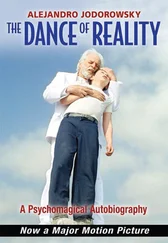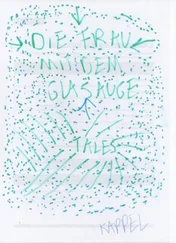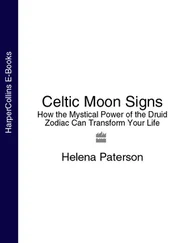What happened?
The first part was based on creations by Topor, Arrabal, and Alain-Yves Leyaouanc. Topor gave me four drawings, which I staged with Graciela Martínez’s ballet company, with suits made of white fabric on which the artist himself drew, and figures carved in wood. That way the public could attend Topor’s ballet, which took place slowly on a black platform. It portrayed the stages of initiation of a very young girl: her first pair of stockings, brought in a little wheelbarrow by an elderly lady without legs; her first pair of shoes; her first bra (two Chaplinesque characters came throwing kicks on an enormous plaster breast, lifting up a cloud of dust); her first lipstick; her first jewelry. .
Arrabal entrusted me with a little four-page comedy: the story of a princess in love with a dog-faced prince who ends up by deception with a bull-faced prince. For this scene, I filled the stage with a thousand chicks chirping deafeningly. The princess masturbated a bullhorn until a stream of milk gushed out. To me, these first two parts constituted understanding the comic-poetic prologue of the “Sacramental Melodrama.” Some of the more well-known American Beat poets, like Allen Ginsberg and Lawrence Ferlinghetti, attended the event. The latter was so impressed that he asked me for a written description of “Sacramental Melodrama” for his City Lights Journal, an article that would be preceded by a little explanatory preface. The simplest is to let you read this document, composed immediately after the event and published in San Francisco in 1966. It conveys all the craziness and the beauty of this ephemeral panic, better than my memory could today.
The goal of theater is to provoke accidents. Theater should be based on what has been called “errors”: ephemeral accidents. In accepting its ephemeral character, theater will discover what distinguishes it from other arts and consequently opens it to its own core. Other arts leave written pages, recordings, canvas, volumes: objective traces that time erases very slowly. Theater itself should not last even a day in the life of a man. Just born, it should immediately die. The only traces it will leave will be carved into the interior of human beings and will manifest in psychological changes. If the objective of other arts is to create oeuvres, the goal of theater is specifically to change man. If theater is not a life science, it cannot know how to be an art.
SACRAMENTAL MELODRAMA
A panic ephemeral presented May 24, 1965, at the Second Festival of Free expression in Paris
A scene from which all the twists, cords, pretenses, and decorations had been removed. In other words, a stage cleaned of all the refuse and triviality: nothing but naked walls.
Everything is painted white, including the floor.
A black automobile (in good condition); the windows are broken so it can shelter things, to be used like a dressing room, a place to rest, and so forth.
Two white boxes on which objects are arranged.
A butcher’s block, a hatchet.
A pot of oil boiling on an electric hot plate.
Before the curtain is raised, large quantities of incense are burned.
All the women are topless.
Two of them, spread out on the ground, are painted entirely in white.
Another woman, painted in black, is atop the roof of the black automobile. At her side, another, painted pink. Both have their feet in a basin of money. A woman dressed in a long silvery dress, her hair arranged in a half-moon, leans on two crutches. Her whole face is masked, including her nose and mouth. Two holes in the dress reveal her nipples; another reveals her pubic hair. She carries a large pair of silver scissors.
One more woman, wearing an executioner’s hood, high leather boots, a thick belt. She holds a whip. Her breasts are covered with a black shawl.
A rock band: six guys with hair to their shoulders.
No one must have taken drugs, except the musicians.
A handrail connects the stage to the public. The objects and costumes used during the show will be thrown at the spectators.
Sudden and rowdy opening of the curtain. The calm before the storm. I appear, dressed in a shiny black plastic suit, high trousers like those of a garbage collector, rubber boots, leather gloves, large plastic glasses. On my head, a white motorcycle helmet, like a big egg.
Two geese. I cut their throats. The music explodes: a cascade of electric guitars.
The birds ramble, dying. Feathers fly. Blood squirts on the two women in white. Trance. I dance with them. I beat them with the dying birds. Noise of death. Blood.
(I had anticipated cutting the birds’ throats on the butcher’s block. But, in my trance, carried away by a strange force, I ripped their necks with my bare hands as easily as if uncorking a bottle.)
The woman in pink, her feet still in the basin, moves her hips, while the woman in black, like a slave, begins to cover her body in honey.
I destroy the geese on the butcher block.
The woman in silver violently opens and closes the scissors. Ah, that metallic sound!
She gives the scissors to the two women in white who begin to cut the black plastic off me.
She destroys my suit. I lose my boots and gloves. Curiously possessed also, the women tear up my suit with their bare hands.
My body is then covered with twenty pounds of steak stitched onto me like a shirt.
Howling, the women hurl the red meat and tear it to shreds piece by piece. They give the pieces to the woman in silver. With an enormous silver knife, she calmly throws the steak into the boiling oil. (The proximity of the hot plate to the sweating bodies of the women produces electric shocks.)
Each piece of meat once fried is put on a white dish; the two women put the dishes in the public’s view.
I remain dressed in black leather pants. A phallus made of the same material is hung perpendicular to the floor. I have leather bracelets on my wrists and ankles: homage to Maciste, the Hercules of the Italian peplum (sword and sandal films). Concentration. Karate-kata.
I take the hatchet and cut my leather phallus into slices on the butcher’s block.
The woman in black, conscious of the skeleton, dances; she moves the bones like a marionette while I break the white dishes with a hammer in one blow.
The women in white dance without stopping. When they feel tired they take the Zazen posture.
I bring a metal frame. Slowly, I lift the black shawl covering the breasts of the executioner. Her skin is not painted. She has a sound and strong chest, a powerful body.
I put the frame around my neck while turning my back to the public.
The woman gives me a lash of the whip.
I trace a red line on her right breast with lipstick.
Second lash of the whip. The line begins at her solar plexus and descends to her vagina.
(The first lash was strong but not so much: I needed more. I sought a still-unknown psychological state. I needed to bleed to transcend myself, to break my own image. The second lash branded me instantly. Then the executioner lost control, for she had often dreamed of flogging a man. The third time, very excited, she lashed me with all her might. The wound took two weeks to heal.)
The woman wants to continue to beat me; she pushes me with all her strength. With the apparatus around my neck, I whirl around and fall to the ground. (I could have broken my cervical vertebrae but, in the strange emotional state where I found myself, time slowed down, and as if I were in a movie in slow motion, I lifted myself up without the slightest injury.) I pinch her breasts to bring her back to herself. Calm.
The woman in black brings me lemons. Ah, this yellow color!
I lay them down in a circle. I kneel in the middle.
Читать дальше












